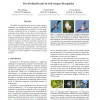Free Online Productivity Tools
i2Speak
i2Symbol
i2OCR
iTex2Img
iWeb2Print
iWeb2Shot
i2Type
iPdf2Split
iPdf2Merge
i2Bopomofo
i2Arabic
i2Style
i2Image
i2PDF
iLatex2Rtf
Sci2ools
136
Voted
CVPR
2012
IEEE
2012
IEEE
Pose pooling kernels for sub-category recognition
The ability to normalize pose based on super-category landmarks can significantly improve models of individual categories when training data are limited. Previous methods have considered the use of volumetric or morphable models for faces and for certain classes of articulated objects. We consider methods which impose fewer representational assumptions on categories of interest, and exploit contemporary detection schemes which consider the ensemble of responses of detectors trained for specific posekeypoint configurations. We develop representations for poselet-based pose normalization using both explicit warping and implicit pooling as mechanisms. Our method defines a pose normalized similarity or kernel function that is suitable for nearest-neighbor or kernel-based learning methods.
| Added | 28 Sep 2012 |
| Updated | 28 Sep 2012 |
| Type | Journal |
| Year | 2012 |
| Where | CVPR |
| Authors | Ning Zhang, Ryan Farrell, Trevor Darrell |
Comments (0)

